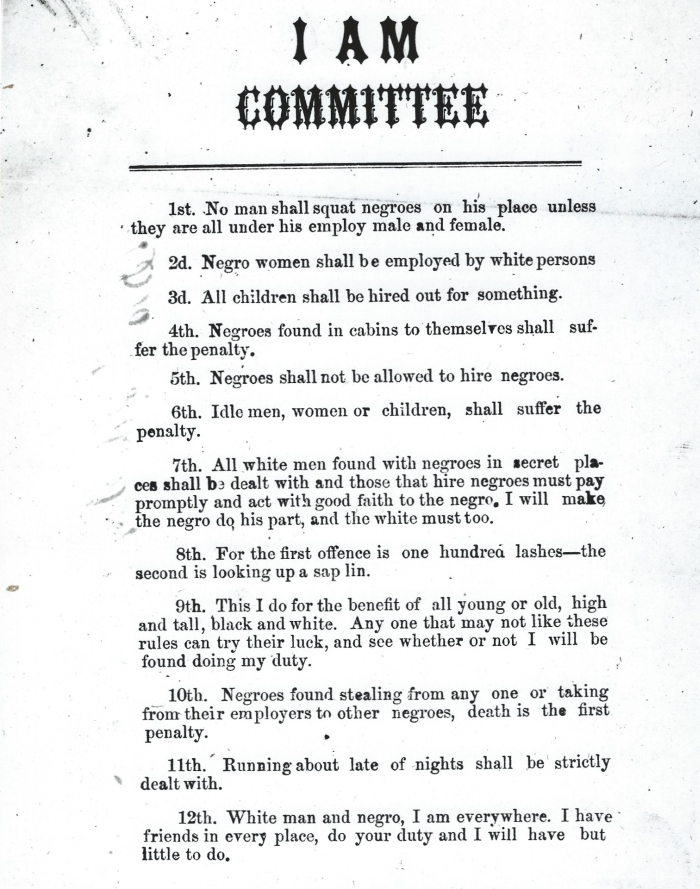Army Officer at Gallatin, Tennessee, to the Headquarters of the Department of the Tennessee, Enclosing an Anonymous Broadside
Gallatin Tenn Jan 29. 67.
Col I have the honor to report that I have taken from a house at “Cross Plains” in Robertson Co, 200 copies of the enclosed “circular”: a number of copies had been distributed to certain persons in that neighborhood, and by some of them, read to the colored people living about, at the same time notifying them that they had “been appointed to “see the rules enforced”, and that they intended to do it
Several of the “circulars” have been nailed to the doors of houses located in that vicinity, about Richland, near this place, and near Springfield Tenn,
I am not certain that any of “the penalties” have been inflicted, the negroes are held in such a state of terror that they dare not tell, and the whites, from sympathy with the villains, will not.
I respectfully ask to be informed if the Dept Commander has any instructions to give in this case
I would also ask if Genl Order No 44 A.G.O. July 6. '66 has been superseded by any subsequent order.1 I am sir Very Respy Your Obt Servt
Chas B. Brady
[Enclosure]
[Robertson County, Tenn., late 1866 or January 1867]

Lt Chas B. Brady to Bvt Lt Col A. L. Hough, 29 Jan. 1867, enclosing “I AM COMMITTEE,” [late 1866 or Jan. 1867], B-10 1867, Letters Received, series 4720, Department of the Tennessee, U.S. Army Continental Commands, Record Group 393 Pt. 1, National Archives. Lieutenant Brady signed as an officer in the 5th Cavalry. In response to his letter, the department commander's chief of staff directed him to arrest “the authors of the Circular, those who posted them, or those who operate under them,” if he could ascertain who they were. General Order 44, he added, had not been superseded. (Bvt. Maj. Wm D Whipple to 2nd Lieut. Chas B. Brady, 9 Feb. 1867, vol. 46 DT, p. 29, Letters Sent, series 909, Department of the Tennessee, U.S. Army Continental Commands, Record Group 393 Pt. 1, National Archives.) The broadside was probably the one reported to be circulating in Sumner and Robertson counties, Tennessee, in the fall of 1866 and attributed to the regulator band led by Ellis Harper. In late October, a freedman named Hudson Groves had described the following exchange with Benjamin F. Roney, a justice of the peace in Sumner County: “He said ‘Hudson what are you going to do about these men riding around’? alluding to armed guerrillas. I answered I dont know Sir– He then said I picked up a paper in the road today I will read to you– He then pulled a paper from his pocket and read to [me] that all black people male and female must be in their master,s yards by Christmas next at the furtherest, or they should look up a rope and the last one of them murdered. And that all Union men, who hired them, or protected them or had any thing do with them should be served the same way.” A Freedmen's Bureau official subsequently described Roney as “one of the men distributing the tract or order of Harper, called the ‘I am committee’.” (Affidavit of Hudson Groves, 30 Oct. 1866, G-105 1866, Registered Letters Received, series 3379, TN Assistant Commissioner, Bureau of Refugees, Freedmen, & Abandoned Lands, Record Group 105, National Archives; Capt Mich. Walsh to Bt Brig Genl J. R. Lewis, 29 Nov. 1866, Reports of Outrages, Riots, & Murders, series 3394, TN Assistant Commissioner, Bureau of Refugees, Freedmen, & Abandoned Lands, Record Group 105, National Archives.)
Published in Land and Labor, 1866–1867, pp. 194–96.
